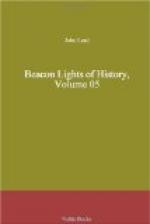Latin in the universities; everywhere war on the Middle
Ages, without full emancipation from their dogmas,
ancient paganism made to uphold the Church, an unbounded
activity of intellect casting off all established
rules, the revival of the old Greek republics, democracy
asserting its claim against absolute power; nothing
settled, nothing at rest, but motion in every direction,—science
combating faith, faith spurning reason, humanity arrogating
divinity, the confusion of races, Babel towers of
vanity and pride in the new projected enterprises,
Christian nations embroiled in constant wars, gold
and silver set up as idols, the rise of new powers
in the shapes of new industries and new inventions,
commerce filling the world with wealth, armies contending
for rights as well as for the aggrandizement of monarchies:
was there ever such a simmering and boiling and fermenting
period of activities since the world began? In
such a wild and tumultuous agitation of passions and
interests and ideas, how could Art reappear either
in the classic severity of Greek temples or the hoary
grandeur of Mediaeval cathedrals? In this jumble
we look for new creations, but no creations in art
appear, only fantastic imitations. There is no
creation except in a new field, that of science and
mechanical inventions,—where there is the
most extraordinary and astonishing development of human
genius ever seen on earth, but “of the earth
earthy,” aiming at material good. Architecture
itself is turned into great feats of engineering.
It does not span the apsis of a church; it spans rivers
and valleys. The church, indeed, passes out of
mind, if not out of sight, in the new material age,
in the multiplication of bridges and gigantic reservoirs,—old
Rome brought back again in its luxuries.
And yet the exactness of science and the severity
of criticism—begun fifty years ago, in
the verification of principles—produce a
better taste. Architects have sought to revive
the purest forms of both Gothic and Grecian.
If they could not create a new style, they would imitate
the old: as in philosophy, they would go round
in the old circles. As science revives the atoms
of Democritus, so art would reproduce the ideas of
Phidias and Vitruvius, and even the poetry and sanctity
of the Middle Ages. Within fifty years Christendom
has been covered with Gothic churches, some of which
are as beautiful as those built by Freemasons.
The cathedrals have been copied rigidly, even for village
churches. The Parthenon reappears in the Madeleine.
We no longer see, as in the eighteenth century, Gothic
spires on Roman basilicas, or Grecian porticos ornamenting
Norman towers. The various styles of two thousand
years are not mixed up in the same building. We
copy either the horizontal lines of Paganism or the
vertical lines of the ages of Faith. No more
harmonious Gothic edifice was ever erected than the
new Catholic cathedral of New York.




